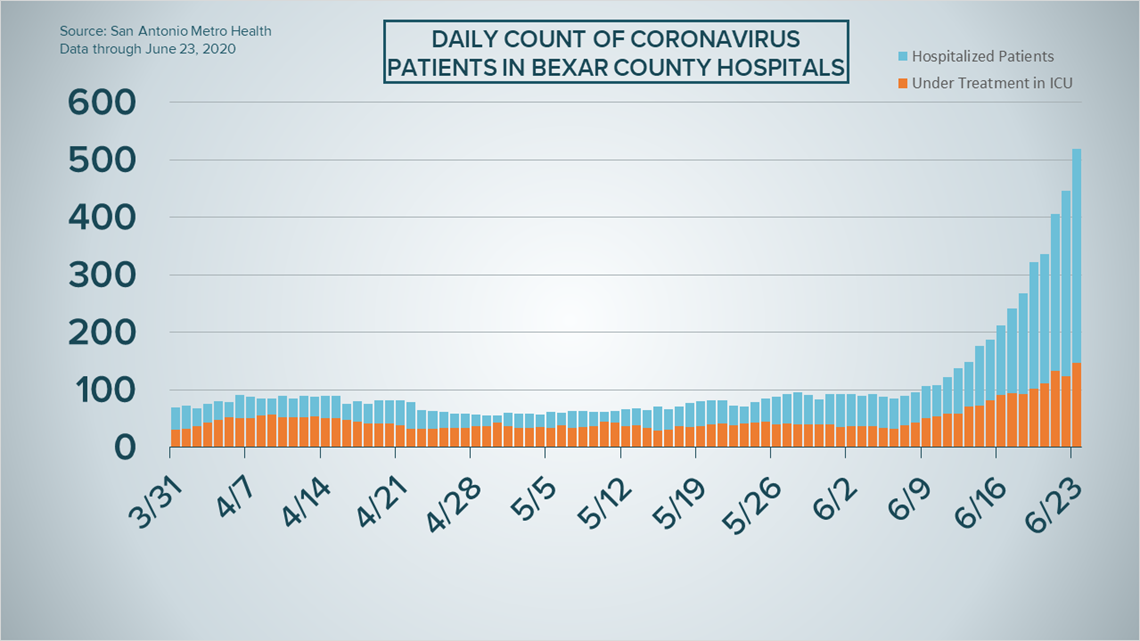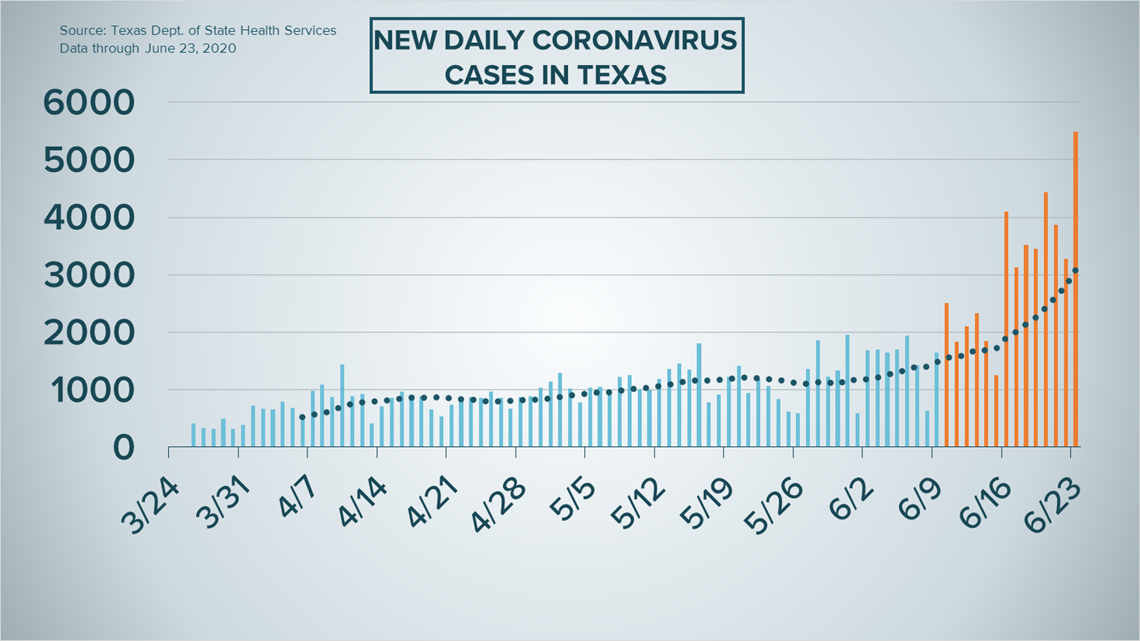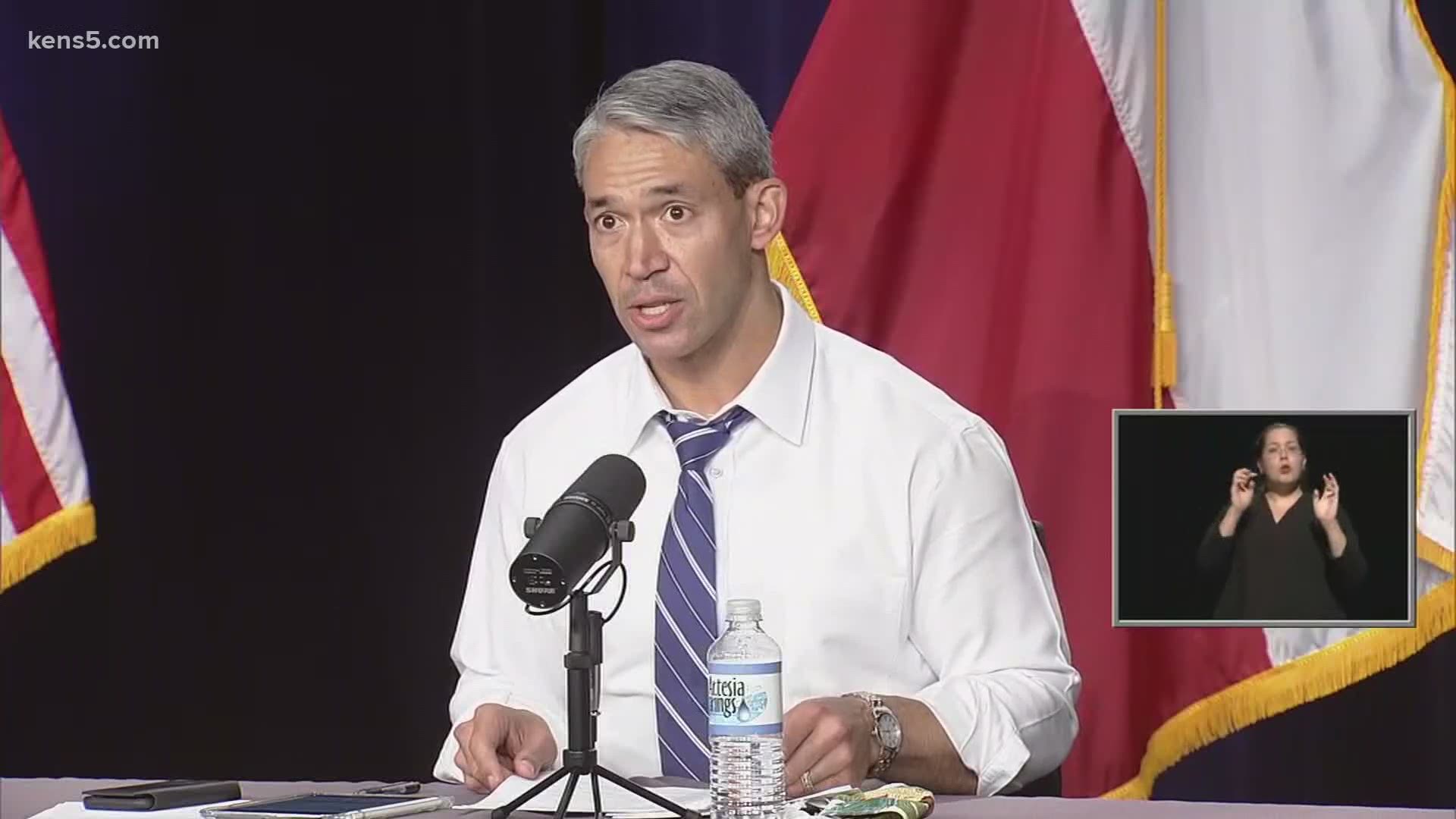SAN ANTONIO — We're tracking the latest numbers from the coronavirus pandemic in San Antonio and across Texas. Here are the latest numbers reported by Bexar and surrounding counties:
- Bexar County: 311 new cases were reported Tuesday, along with three new virus-related deaths. There is a total of 7,467 cases and 100 fatalities. More than 400 patients are in local hospitals.
- Comal County: 52 new confirmed cases were reported Saturday, along with 21 additional probable cases. The combined total has now risen to 419 confirmed cases. Seven people have died in the county, while 191 have recovered. The county's positivity rate is up to 8.2%, the highest since April 14.
- Hays County: 160 new cases Monday, bringing the total to 1,871 cases and five fatalities in the county. 54% of the country's confirmed cases are people between the ages of 20 and 29.
Here are Tuesday's full numbers. Bexar County reports them daily at 7 p.m.
How Bexar County is trending:
We're tracking how many coronavirus cases are confirmed in Bexar County each day from the time San Antonio Metro Health began reporting cases more than two months ago. Graphing those daily case numbers along a 14-day moving average provides an accurate picture of the curve in the San Antonio area and the direction we're heading amid the coronavirus.
Mayor Nirenberg reported 311 additional cases on Tuesday, bringing the county total to 7,467. He also reported three new deaths, bringing the total to 100.


The number of Bexar County residents being admitted to local hospitals with the coronavirus also continues to outpace the number of patients being discharged, continuing a trend that has been in place for about two weeks. As of Tuesday, 518 county residents with the coronavirus were being treated in area hospitals.
This is a new record high, and there has been a new record high in the county every day for the past two weeks.


Coronavirus in Texas
Texas reached a grim milestone Tuesday with a drastic new high in daily COVID-19 cases, with 5,481. It's the first time state health officials reported a daily count of at least 5,000 new cases, and brings the cumulative total for the state to 120,370 cases during this pandemic. This marks the eighth day in a row the state reported at least 3,000 new cases; before June 16, there were no such days.
Meanwhile, 28 new deaths from virus-related complications were also reported, bringing the total for Texas to 2,220.
Here's a look at the 14-day moving average of the new daily coronavirus cases in Texas, which today climbed past 3,000 per day:


Meanwhile, the number of current hospitalizations from the coronavirus in Texas breached 4,000 for the first time, with 381 new hospitalizations bringing the total to 4,092. Tuesday marks the 12th consecutive day with a new record high for Texans in the hospital.
LATEST CORONAVIRUS HEADLINES:
- Texas universities are shelving SAT and ACT requirements as coronavirus scrambles admissions process
- Fauci hopeful for COVID-19 vaccine by end of the year or early 2021
- Draft documents show Texas planning few mandatory safety measures when public schools reopen in fall
- Dr. Fauci says coronavirus task force was never asked to slow down testing
- Demand for plasma increases tenfold in San Antonio amid COVID-19 surge
- Is it safe to form a COVID-19 'support bubble' with friends?
- Bexar County health officials warn we could see nearly a million coronavirus cases by August at current rate
- Coronavirus fears postponed a Texas election. Now it will go forward with even greater risk for some voters.
Coronavirus symptoms
The symptoms of coronavirus can be similar to the flu or a bad cold. Symptoms include fever or chills, cough, shortness of breath or difficulty breathing, fatigue, muscle or body aches, headache, new loss of taste or smell sore throat, congestion or runny nose, nausea or vomiting and diarrhea, according to the Centers for Disease Control.
Most healthy people will have mild symptoms. A study of more than 72,000 patients by the Centers for Disease Control in China showed 80 percent of the cases there were mild.
But infections can cause pneumonia, severe acute respiratory syndrome, kidney failure, and even death, according to the World Health Organization. Older people with underlying health conditions are most at risk.
The CDC believes symptoms may appear anywhere from two to 14 days after being exposed.
Human coronaviruses are usually spread...
- Between people who are in close contact with one another (within about 6 feet).
- Through respiratory droplets produced when an infected person coughs, sneezes or talks. These droplets can land in the mouths or noses of people who are nearby or possibly be inhaled into the lungs.
- Some recent studies have suggested that COVID-19 may be spread by people who are not showing symptoms.
Help stop the spread of coronavirus
- Stay home when you are sick.
- Eat and sleep separately from your family members
- Use different utensils and dishes
- Cover your cough or sneeze with your arm, not your hand.
- If you use a tissue, throw it in the trash.
Lower your risk
- Wash your hands often with soap and water for at least 20 seconds. If soap and water are not available, use an alcohol-based hand sanitizer.
- Avoid touching your eyes, nose, and mouth with unwashed hands.
- Avoid close contact with people who are sick.
- Clean and disinfect frequently touched objects and surfaces.
- The CDC recommends wearing a mask or cloth face covering if you have to be out due to an essential service or essential activity such as going to the grocery store.
- If you are 60 or over and have an underlying health condition such as cardiovascular disease, diabetes or respiratory illnesses like asthma or COPD, the World Health Organization advises you to try to avoid crowds or places where you might interact with people who are sick.

